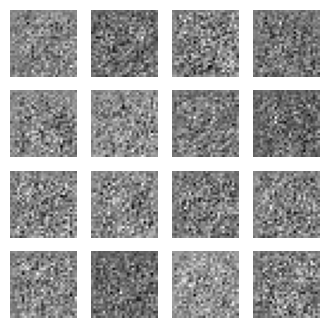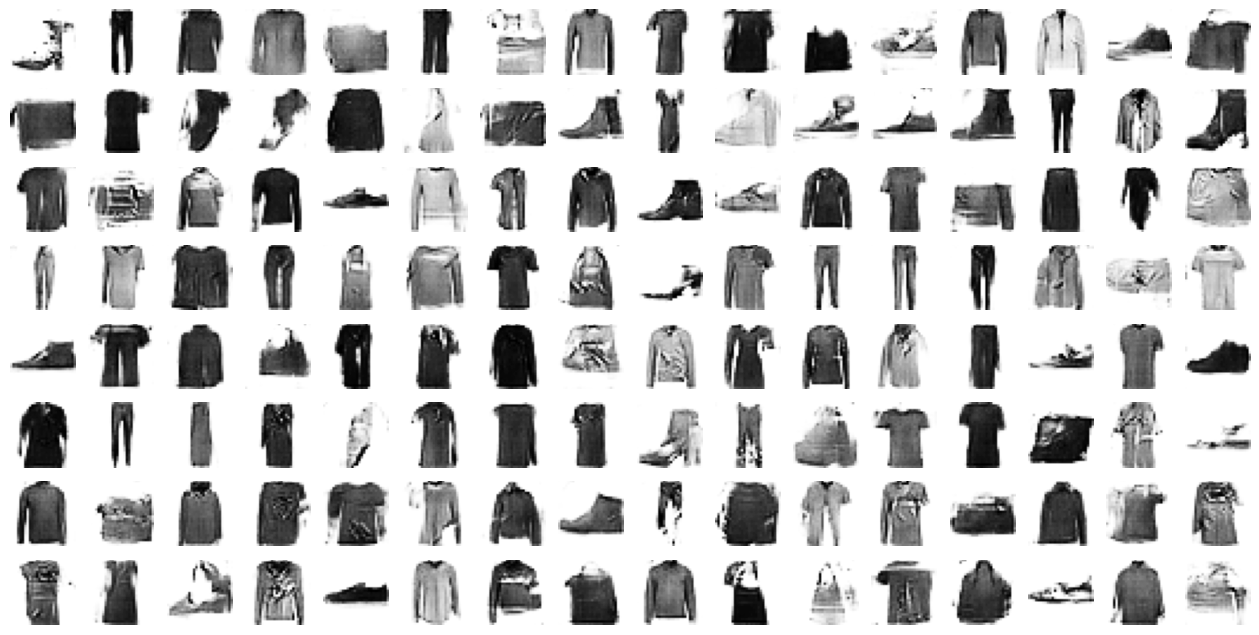Coursera
Ungraded Lab: First DCGAN
In this lab, you will see a demo of a Deep Convolutional GAN (DCGAN) trained on Fashion MNIST. You’ll see architectural differences from the GAN in the first lab and also see the best practices when building this network.
Imports
import tensorflow as tf
import tensorflow.keras as keras
import numpy as np
import matplotlib.pyplot as plt
from IPython import display
Utilities
def plot_results(images, n_cols=None):
'''visualizes fake images'''
display.clear_output(wait=False)
n_cols = n_cols or len(images)
n_rows = (len(images) - 1) // n_cols + 1
if images.shape[-1] == 1:
images = np.squeeze(images, axis=-1)
plt.figure(figsize=(n_cols, n_rows))
for index, image in enumerate(images):
plt.subplot(n_rows, n_cols, index + 1)
plt.imshow(image, cmap="binary")
plt.axis("off")
Download and Prepare the Dataset
You will use the Fashion MNIST dataset for this exercise. As before, you will only need to create batches of the training images. The preprocessing steps are also shown below.
# download the training images
(X_train, _), _ = keras.datasets.fashion_mnist.load_data()
# normalize pixel values
X_train = X_train.astype(np.float32) / 255
# reshape and rescale
X_train = X_train.reshape(-1, 28, 28, 1) * 2. - 1.
BATCH_SIZE = 128
# create batches of tensors to be fed into the model
dataset = tf.data.Dataset.from_tensor_slices(X_train)
dataset = dataset.shuffle(1000)
dataset = dataset.batch(BATCH_SIZE, drop_remainder=True).prefetch(1)
Downloading data from https://storage.googleapis.com/tensorflow/tf-keras-datasets/train-labels-idx1-ubyte.gz
29515/29515 [==============================] - 0s 1us/step
Downloading data from https://storage.googleapis.com/tensorflow/tf-keras-datasets/train-images-idx3-ubyte.gz
26421880/26421880 [==============================] - 2s 0us/step
Downloading data from https://storage.googleapis.com/tensorflow/tf-keras-datasets/t10k-labels-idx1-ubyte.gz
5148/5148 [==============================] - 0s 0us/step
Downloading data from https://storage.googleapis.com/tensorflow/tf-keras-datasets/t10k-images-idx3-ubyte.gz
4422102/4422102 [==============================] - 1s 0us/step
Build the Model
In DCGANs, convolutional layers are predominantly used to build the generator and discriminator. You will see how the layers are stacked as well as the best practices shown below.
Generator
For the generator, we take in random noise and eventually transform it to the shape of the Fashion MNIST images. The general steps are:
- Feed the input noise to a dense layer.
- Reshape the output to have three dimensions. This stands for the (length, width, number of filters).
- Perform a deconvolution (with Conv2DTranspose), reducing the number of filters by half and using a stride of
2. - The final layer upsamples the features to the size of the training images. In this case 28 x 28 x 1.
Notice that batch normalization is performed except for the final deconvolution layer. As best practice, selu is the activation used for the intermediate deconvolution while tanh is for the output. We printed the model summary so you can see the shapes at each layer.
codings_size = 32
generator = keras.models.Sequential([
keras.layers.Dense(7 * 7 * 128, input_shape=[codings_size]),
keras.layers.Reshape([7, 7, 128]),
keras.layers.BatchNormalization(),
keras.layers.Conv2DTranspose(64, kernel_size=5, strides=2, padding="SAME",
activation="selu"),
keras.layers.BatchNormalization(),
keras.layers.Conv2DTranspose(1, kernel_size=5, strides=2, padding="SAME",
activation="tanh"),
])
generator.summary()
Model: "sequential"
_________________________________________________________________
Layer (type) Output Shape Param #
=================================================================
dense (Dense) (None, 6272) 206976
reshape (Reshape) (None, 7, 7, 128) 0
batch_normalization (Batch (None, 7, 7, 128) 512
Normalization)
conv2d_transpose (Conv2DTr (None, 14, 14, 64) 204864
anspose)
batch_normalization_1 (Bat (None, 14, 14, 64) 256
chNormalization)
conv2d_transpose_1 (Conv2D (None, 28, 28, 1) 1601
Transpose)
=================================================================
Total params: 414209 (1.58 MB)
Trainable params: 413825 (1.58 MB)
Non-trainable params: 384 (1.50 KB)
_________________________________________________________________
As a sanity check, let’s see the fake images generated by the untrained generator and see the dimensions of the output.
# generate a batch of noise input (batch size = 16)
test_noise = tf.random.normal([16, codings_size])
# feed the batch to the untrained generator
test_image = generator(test_noise)
# visualize sample output
plot_results(test_image, n_cols=4)
print(f'shape of the generated batch: {test_image.shape}')
shape of the generated batch: (16, 28, 28, 1)

Discriminator
The discriminator will use strided convolutions to reduce the dimensionality of the input images. As best practice, these are activated by LeakyRELU. The output features will be flattened and fed to a 1-unit dense layer activated by sigmoid.
discriminator = keras.models.Sequential([
keras.layers.Conv2D(64, kernel_size=5, strides=2, padding="SAME",
activation=keras.layers.LeakyReLU(0.2),
input_shape=[28, 28, 1]),
keras.layers.Dropout(0.4),
keras.layers.Conv2D(128, kernel_size=5, strides=2, padding="SAME",
activation=keras.layers.LeakyReLU(0.2)),
keras.layers.Dropout(0.4),
keras.layers.Flatten(),
keras.layers.Dense(1, activation="sigmoid")
])
discriminator.summary()
Model: "sequential_1"
_________________________________________________________________
Layer (type) Output Shape Param #
=================================================================
conv2d (Conv2D) (None, 14, 14, 64) 1664
dropout (Dropout) (None, 14, 14, 64) 0
conv2d_1 (Conv2D) (None, 7, 7, 128) 204928
dropout_1 (Dropout) (None, 7, 7, 128) 0
flatten (Flatten) (None, 6272) 0
dense_1 (Dense) (None, 1) 6273
=================================================================
Total params: 212865 (831.50 KB)
Trainable params: 212865 (831.50 KB)
Non-trainable params: 0 (0.00 Byte)
_________________________________________________________________
As before, you will append these two subnetwork to build the complete GAN.
gan = keras.models.Sequential([generator, discriminator])
Configure the Model for training
The discriminator and GAN will still be classifying fake and real images so you will use the same settings as before.
discriminator.compile(loss="binary_crossentropy", optimizer="rmsprop")
discriminator.trainable = False
gan.compile(loss="binary_crossentropy", optimizer="rmsprop")
Train the Model
The training loop will also be identical to the previous one you built. Run the cells below and observe how the fake images become more convincing as the training progresses.
def train_gan(gan, dataset, random_normal_dimensions, n_epochs=50):
""" Defines the two-phase training loop of the GAN
Args:
gan -- the GAN model which has the generator and discriminator
dataset -- the training set of real images
random_normal_dimensions -- dimensionality of the input to the generator
n_epochs -- number of epochs
"""
generator, discriminator = gan.layers
for epoch in range(n_epochs):
print("Epoch {}/{}".format(epoch + 1, n_epochs))
for real_images in dataset:
# infer batch size from the training batch
batch_size = real_images.shape[0]
# Train the discriminator - PHASE 1
# create the noise
noise = tf.random.normal(shape=[batch_size, random_normal_dimensions])
# use the noise to generate fake images
fake_images = generator(noise)
# create a list by concatenating the fake images with the real ones
mixed_images = tf.concat([fake_images, real_images], axis=0)
# Create the labels for the discriminator
# 0 for the fake images
# 1 for the real images
discriminator_labels = tf.constant([[0.]] * batch_size + [[1.]] * batch_size)
# ensure that the discriminator is trainable
discriminator.trainable = True
# use train_on_batch to train the discriminator with the mixed images and the discriminator labels
discriminator.train_on_batch(mixed_images, discriminator_labels)
# Train the generator - PHASE 2
# create a batch of noise input to feed to the GAN
noise = tf.random.normal(shape=[batch_size, random_normal_dimensions])
# label all generated images to be "real"
generator_labels = tf.constant([[1.]] * batch_size)
# freeze the discriminator
discriminator.trainable = False
# train the GAN on the noise with the labels all set to be true
gan.train_on_batch(noise, generator_labels)
# plot the fake images used to train the discriminator
plot_results(fake_images, 16)
plt.show()
train_gan(gan, dataset, codings_size, 100)

Epoch 18/100
---------------------------------------------------------------------------
KeyboardInterrupt Traceback (most recent call last)
<ipython-input-10-c59a7941e802> in <cell line: 1>()
----> 1 train_gan(gan, dataset, codings_size, 100)
<ipython-input-9-98ba34ca2f4f> in train_gan(gan, dataset, random_normal_dimensions, n_epochs)
46
47 # train the GAN on the noise with the labels all set to be true
---> 48 gan.train_on_batch(noise, generator_labels)
49
50 # plot the fake images used to train the discriminator
KeyboardInterrupt: